Living Planet
Nature · Earth · ClimateNature Notes: April 2021
HAIL MARY!
"Spring was moving in the air above and in the earth below and around him, penetrating even his dark and lowly little house with its spirit of divine discontent and longing." (Kenneth Grahame writing about Mole in 'The Wind in the Willows').
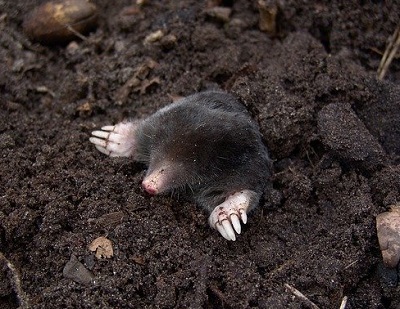
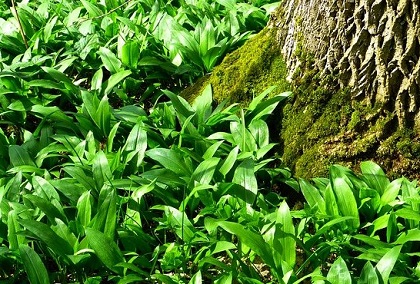
There is currently a playfulness in nature as winged friends hop upon branches and dive into the energizing, blossom-scented air: the promise of a world that's soon to be bountiful again! As I write, and we approach Easter, spring has been advancing like a tide - one moment the warm sunshine coaching open flowers and buds and triggering the start of the breeding season, the next retreating as billowing stormy Mammatus clouds bring a destructive bitterness. Big, pea-sized hailstones have covered fields in clumps of what looked like giant roe - or manna from heaven. The inclement weather no doubt contributed to the tragic loss of splay-legged, gambolling lambs at a nearby farm on 4 consecutive days and newly-built nests were tossed from trees, but there have been happier 'finds' to observe up-close daily, along Slinfold's shoreline: broken twigs of velvet pussy willow strewn upon paths, a bustling vole amongst the lush, fleshy leaves of rapidly growing Ransom beside a stream, the deep red spirals of a striking snail shell in bare mud, near my foot. It's as if life is balancing on a fine, but strong, wisp of a gleaming cobweb.
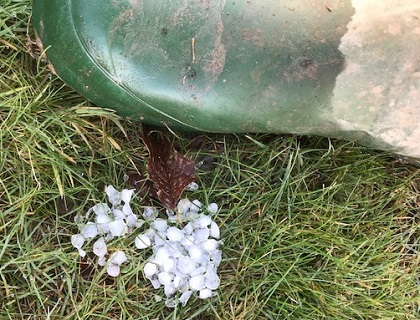
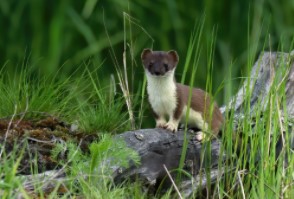
I was striding across a lush green field, breathing in the hushed, late afternoon, golden light when the long, lean, dark brown upper body of a stoat streaked across my path towards the far hedgerow and down to the stream. A flash of white and a black tip to his tail (thought to distract birds of prey) and he/she was gone. Stoats are reputed to perform a mesmerising dance in front of rabbits to hypnotise them before pouncing, but their 'leaping' dance could also be less to do with the joys of spring or a genuine hunting technique and more to do with a parasite infection! This month the females will be giving birth to between 5-12 kits in one of their many dens made of grass and leaves in hollow trunks, banks, thickets, stone piles/walls and even the surface tunnels of mole hills. Meanwhile dear 'Moley' sleeps, eats and breeds in his burrow, Mrs Mole giving birth to just one litter a year (3-4 naked pups born around about now) in a nest deep in one of the many tunnel chambers which otherwise help drain and aerate our heavy clay soils.
Flower beds and banks are now full of flowers in pastel hues, green buds on trees are unfurling their first leaves and early orange-tip butterflies are emerging and flitting through damp meadows and along our country lanes where garlic mustard and cuckoo flower grow. It feels like 'the dressing' of the entire countryside, in preparation for nature's new babies and the return of our winged visitors from overseas. Whilst we await the swallows from the areas like the Cape of Good Hope back to the exact places they were born (amazingly guided by the sun, the earth's magnetic field and landmarks for the last few miles), the Taiga Bean Goose I saw at the Furnace Lakes (rare this far south as they mainly overwinter in Scotland and Norfolk) together with a pale white/fawn coloured 'leucistic' Canada Goose should soon be leaving us to make their way back to Scandinavia to breed.
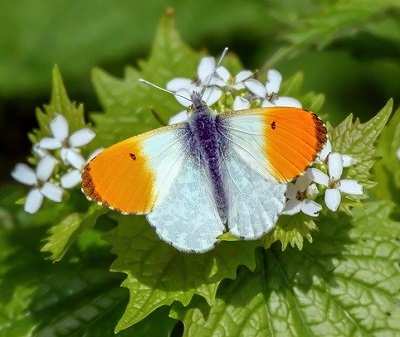
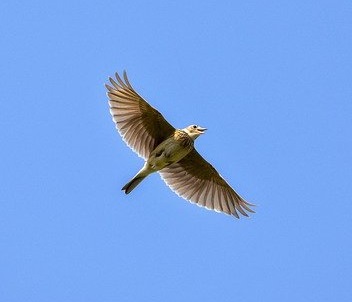
Meanwhile it's already well and truly nesting season here. Running from March - end August (and some birds a bit before and after) all wild birds, nests and eggs are protected by law and it's also illegal to cut hedges. Sussex Wildlife Trust have produced a helpful, downloadable guide for gardeners. Not far from us as the crow flies, or in this case the stork, two at Knepp, were observed building a nest on 2nd March which is around when garden birds were seen collecting nest material here. Up above, two skylarks, soared across the skies, one in hot pursuit of the other, identifiable by their distinctive and wonderfully addictive babbling arias- it's breeding season for them too. Meanwhile, nearer the ground, the wonderful whistled, flute-like tune of the Song Thrush has often been the last bird to stop singing these lighter evenings. Both Song Thrushes and Skylarks have suffered huge declines around farmlands due to changes in agricultural practices and whilst Skylarks are ground nesting birds and still need open spaces with longish grass/crops, Song Thrushes are now more likely to make nests in and around our gardens where the use of *slug pellets can kill them and their young.
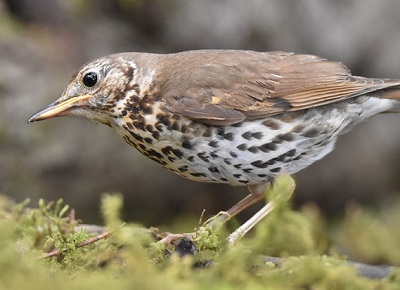
I once found a Song Thrush anvil - a stone on which it repeatedly bashes open its favourite food. A scattering of crushed, coloured, snail shell fragments lay alongside, which were the remains of 'Banded' or 'Brown-lipped' Snails. These are the most colourful and variable in the UK found on a variety of plants, sometimes nettles or buttercups but mainly dead or decaying vegetation (so they aren't a nuisance to gardeners). Their shells may be variations of yellow, pink or brown and may have up to 5 light or dark brown bands round them or none at all. It's been suggested that the variety is down to camouflage - pink or brown shells are much less conspicuous on shaded bare soil or dead woodland leaves, the yellow are more disguised in green vegetation and sunny locations and the stripey ones are better hidden when resting on plant stems and in hedgerows. The single reddish snail shell I came across on a muddy path, matched the reddish-brown beech-leaf litter in the nearby woods.
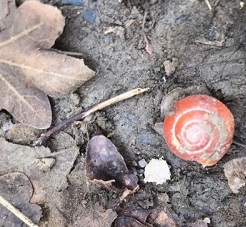
Snails too have a breeding season and whilst hermaphrodite, they still need to mate to fertilise their own eggs (up to 100) before burying them in the soil. Few will hatch as they're vulnerable to predators but those that do, will eat the eggshell they've just emerged from, for nourishment. So, there's your excuse, if you need one, for eating just one more Easter egg this month - 'nourishment' of the chocolate variety, as well as participating in your very own nature-nesting season! Wishing you all a month of new beginnings and the hope that Spring has well and truly sprung in your household ...
*As an alternative to slug pellets, which kill Thrushes and other birds and mammals including hedgehogs, and poison pets, try sprinkling coffee grounds and other natural materials such as bark, crushed eggshells, wood ash and soot on the ground around plants to make natural slug barriers that are safe and effective.